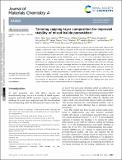| dc.contributor.author | Hartono, Noor Titan Putri | |
| dc.contributor.author | Tremblay, Marie-Hélène | |
| dc.contributor.author | Wieghold, Sarah | |
| dc.contributor.author | Dou, Benjia | |
| dc.contributor.author | Thapa, Janak | |
| dc.contributor.author | Tiihonen, Armi | |
| dc.contributor.author | Bulovic, Vladimir | |
| dc.contributor.author | Nienhaus, Lea | |
| dc.contributor.author | Marder, Seth R | |
| dc.contributor.author | Buonassisi, Tonio | |
| dc.contributor.author | Sun, Shijing | |
| dc.date.accessioned | 2022-02-10T15:53:18Z | |
| dc.date.available | 2022-02-10T15:53:18Z | |
| dc.date.issued | 2021-12-21 | |
| dc.identifier.issn | 2050-7496 | |
| dc.identifier.uri | https://hdl.handle.net/1721.1/140258 | |
| dc.description.abstract | Incorporating a low dimensional (LD) perovskite capping layer on top of a perovskite absorber, improves the stability of perovskite solar cells (PSCs). However, in the case of mixed-halide perovskites, which can undergo halide segregation into single-halide perovskites, a systematic study of the capping layer's effect on mixed-halide perovskite absorber is still lacking. This study bridges this gap by investigating how the 1D perovskite capping layers on top of MAPb(IxBr1−x)3 (x = 0, 0.25, 0.5, 0.75, 1) absorbers affect the films' stability. We utilize a new method, dissimilarity matrix, to investigate the image-based stability performance of capping-absorber pair compositions across time. This method overcomes the challenge of analyzing various film colors due to bandgap difference in mixed-halide perovskites. We also discover that the intrinsic absorber stability plays an important role in the overall stability outcome, despite the capping layer's support. Within the 55 unique capping-absorber pairs, we observe a notable 1D perovskite material, 1-methoxynaphthalene-2-ethylammonium chloride (2MeO–NEA–Cl or 9-Cl), that improves the stability of MAPbI3 and MAPb(I0.5Br0.5)3 by at least 8 and 1.5 times, respectively, compared to bare films under elevated humidity and temperature. Surface photovoltage results also show that the accumulation of electrostatic charges on the film surface depends on the capping layer type, which could contribute to the acceleration/deceleration of degradation. | en_US |
| dc.language.iso | en | |
| dc.publisher | Royal Society of Chemistry (RSC) | en_US |
| dc.relation.isversionof | 10.1039/d1ta07870d | en_US |
| dc.rights | Creative Commons Attribution NonCommercial License 3.0 | en_US |
| dc.rights.uri | https://creativecommons.org/licenses/by-nc/3.0/ | en_US |
| dc.source | Royal Society of Chemistry (RSC) | en_US |
| dc.title | Tailoring capping-layer composition for improved stability of mixed-halide perovskites | en_US |
| dc.type | Article | en_US |
| dc.identifier.citation | Hartono, NTP; Tremblay, M-H; Wieghold, S; Dou, B; Thapa, J; Tiihonen, A; Bulovic, V; Nienhaus, L; Marder, SR; Buonassisi, T; Sun, S, Tailoring capping-layer composition for improved stability of mixed-halide perovskites, J. Mater. Chem. A, 2022,10, 2957-2965 | en_US |
| dc.contributor.department | Massachusetts Institute of Technology. Photovoltaic Research Laboratory | |
| dc.contributor.department | Massachusetts Institute of Technology. Department of Mechanical Engineering | |
| dc.contributor.department | Massachusetts Institute of Technology. Department of Electrical Engineering and Computer Science | |
| dc.contributor.department | Massachusetts Institute of Technology. Research Laboratory of Electronics | |
| dc.relation.journal | Journal of Materials Chemistry A | en_US |
| dc.eprint.version | Final published version | en_US |
| dc.type.uri | http://purl.org/eprint/type/JournalArticle | en_US |
| eprint.status | http://purl.org/eprint/status/PeerReviewed | en_US |
| dc.date.updated | 2022-02-10T15:45:13Z | |
| dspace.orderedauthors | Hartono, NTP; Tremblay, M-H; Wieghold, S; Dou, B; Thapa, J; Tiihonen, A; Bulovic, V; Nienhaus, L; Marder, SR; Buonassisi, T; Sun, S | en_US |
| dspace.date.submission | 2022-02-10T15:45:15Z | |
| mit.journal.volume | 10 | en_US |
| mit.metadata.status | Authority Work Needed | en_US |
